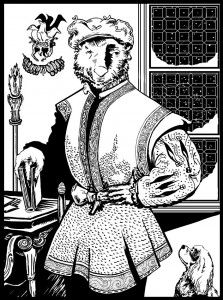by Thom Ryng
The continent of Sahûl was united into the Second Empire by Paharnes the Great in the early Ninth Century of the current era. Drawing on a peculiarly Wenemet notion of feudalism, Paharnes created a multi-religious multi-racial feudal Empire united only in their loyalty to the person of the Emperor and those institutions that gathered around him in the capital at Sardarthion.
Through the centuries, the power of the Empire over its constituent Realms has waxed and waned. During its strong phases, the continent was at peace, and learning and commerce flourished. During its weak phases, Sahûl was convulsed by war and destruction.Such was the Empire through two dynasties and an agonising civil war, until the death of Paharnes VI in 1385 without issue.
The great Clans of Sahûl were determined not to repeat the succession crisis that precipitated the previous dynastic change. Accordingly, they chose the elected Prince of the merchantile Republic of Erphan as Emperor Dronex I.
Having no dynastic roots himself, Dronex promised to the great Clans a new model of Empire. He delivered on his promise in the following year with the promulgation of the Golden Edict.
The Golden Edict enshrined the nine most powerful constituent Realms of the Empire as Sovereign Electors, with the right to choose the new Emperor upon the death of the old.
The nine are: the King of Aradéc, the Grand Duke of Atuburrk, the Grand Duke of Averon, the Prince of Cappargarnia (formerly Erphan), the Queen of Chi’tixi, the Grand Duke of Golmath, the Princess of Itaxik, the Count Palatine of Thace, and the King of Zarkhandu.
Whatever the intent, the effect of the electoral system has been the weakening of the Emperor at the expense of the Electors and (to a lesser extent) the other constituent Realms. The Imperial office has ping-ponged amongst the various Electors in the century since. With almost each election, the central authority has drained away.
Although the Empire has weakened as an institution, the new political situation has given rise to a renaissance of art, technology, and culture not seen on Sahûl in centuries. Will this sudden flowering continue, or will the weakened Empire revert to its age-old pattern of senseless slaughter? Or will a balance somehow be struck?
Note: In recent years, the Emperor Sydath II has issued a new, Great Charter, which has overturned the Sahûlian political landscape. Itaxik and Zarkhandu lost their electoral seats to Araxes and Taneki, and new institutions have joined the College of Electors and the Emperor: a House of Peers and an Imperial Chamber Court.




